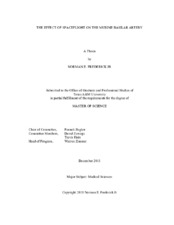| dc.description.abstract | Spaceflight poses a serious risk to human cardiovascular health in the form of
microgravity-induced fluid shifts, exposure to ionizing space radiation, and unique
environmental factors. The combinatorial effects of increased intracranial pressure and
high pCOv2 levels on the International Space Station have led to particular concern about
cerebral arteries. Two prior studies aimed at examining specific spaceflight-induced
changes in murine basilar artery function yielded very different results. Therefore, the goal
of this study, part of the NASA Rodent Research 9 mission, was to investigate mechanisms
underlying pathophysiological changes in the murine basilar artery and to clarify
conflicting results from previous studies.
To achieve this goal, we used the technique of wire myography to examine the structural,
mechanical, and pharmacological properties of basilar arteries from mice that had
experienced 33 days of spaceflight on the International Space Station. Spaceflown mice
were compared to a habitat control group, which was exposed to matched environmental
conditions but not microgravity and radiation, and a vivarium control group, which was
exposed to none of the aforementioned stimuli.
Although body weight, basilar artery diameter, and passive pressure-diameter relationship
were not different between habitat control, vivarium control, and spaceflight groups, we
found that spaceflight induced significant changes in the response of the murine basilar
artery to pharmacological agents. Vasoconstriction to U46619 and KCl was diminished to
varying degrees in the spaceflight group, as was endothelial-independent vasodilation to
DEA-NONOate. Endothelial-dependent nitric oxide-mediated vasodilation in response to
acetylcholine, but not ADPβS, was shown to be reduced in the spaceflight group compared
to the vivarium control group.
Unaltered structural and mechanical properties and decreased U46619- and KCl-mediated
vasoconstriction supplement results from a prior study of murine basilar arteries following
spaceflight. Preserved vasodilation to ADPβS but not acetylcholine after KCl
preconstriction may suggest that spaceflight differentially affects endothelial dilatory
pathways. The decrement in endothelial-independent vasodilation, a feature never
previously observed in spaceflown mice, presents a new dimension of spaceflight-induced
vascular dysfunction. | en |


